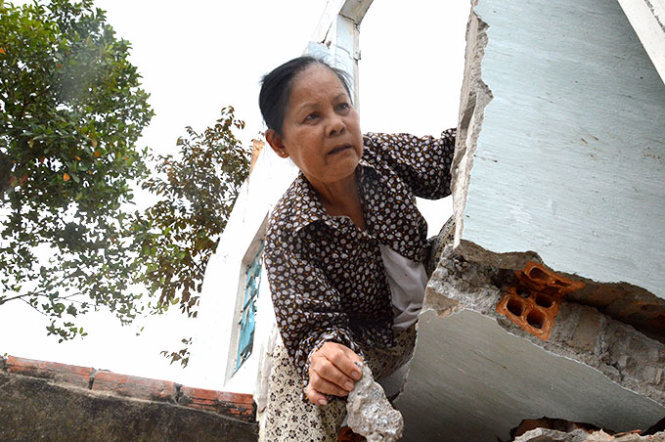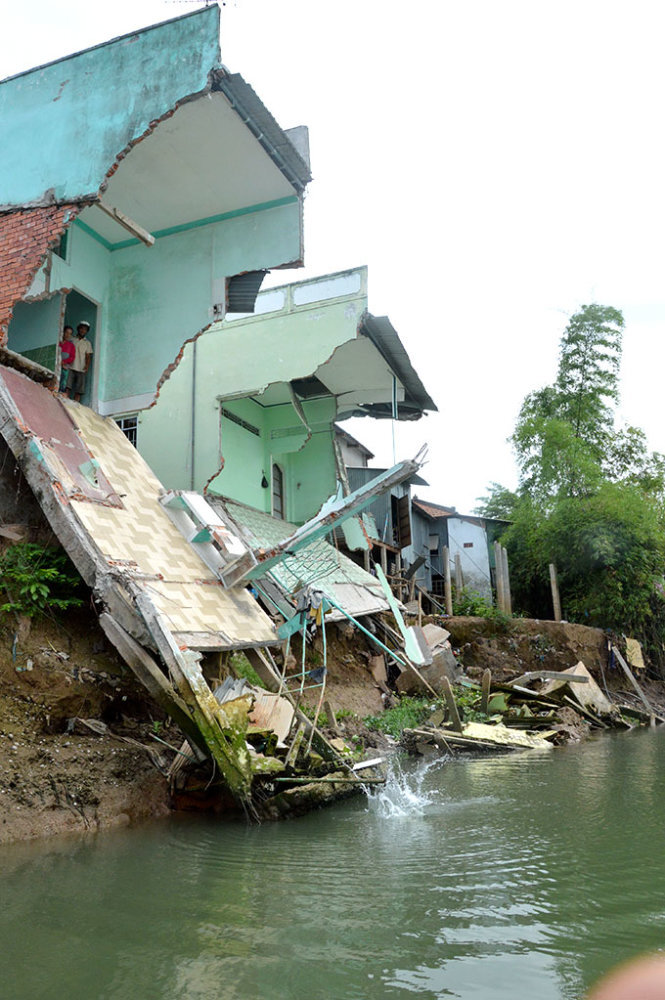'Development' at crossroads: The destruction of rivers to build highways
A house split into two by land subsidence. Image Copyright of Tuoi Tre. Used with kind permission
Development is a term fraught with difficult choices. Our quest for rapid urbanisation though, comes at a devastating price. Infrastructure and real-estate development threatens a wide variety of natural ecosystems and all those who depend on them. For today, I'd like to focus on the story of a river that's been ravaged in Vietnam. This is a story that is repeating itself across many other rivers in Vietnam and scores of other developing countries, often with support from international funding.
The construction of the Da Nang – Quang Ngai Highway in central Vietnam began in 2013. It was funded by the Government of Vietnam, The World Bank and the Japan International Co-operation Agency (JICA). They sanctioned US$1.4 billion for this key highway that will connect the north and the south. Work was scheduled to be finished in 2017 but the project has been delayed due to difficulties with compensation for those affected by land acquisition. Once completed, the key expressway (about 140 km long) is expected to reduce traffic congestion and increase economic vialability in the region, particularly the economic triangle between Laos, Cambodia and Vietnam through the East-West corridor to seaports in central Vietnam. National defence-security in the central region will also benefit from this project. The finished project will feature six lanes, five cross sections, nine intersections, 107 underground culverts, 492 drainage culverts, 130 bridges, a 540m long two-lane tunnel and four parking yards.
But at what cost?
The construction of this highway has been made possible by large quantities of sand (26 million cubic meters) excavated from important rivers such as the Vu Gia - Thu Bon River in Dien Quang Commune, Dien Ban Town, Quang Nam Province. Sand extraction has been going on round-the-clock decimating the river basin and all those who depend on its ecosystem services. Rampant legal and illegal sand mining from the river has resulted in damage to agriculture on both banks of the river as well as fishing along the river. It has also exacerbated in-land and coastal erosion. As a result, land along the riverbanks has 'evaporated' and many have lost not only their property but also their means of livelihood. Village roads on both sides of the river have been inundated with hundreds of trucks as the river bed has been turned into a mining site. Brazen sand miners have even built an illegal road across the river to connect both banks when water levels are low.
People's protests have fallen on deaf ears. The Environmental Impact Assessment for the project fails to address any of these issues effectively. Elsewhere in Vietnam, indiscriminate sand mining has also damaged other rivers and caused land subsidence (See Jargon Buster in the Community Resources Page) resulting in people losing homes that they saved up for years to build. It has also caused landslides that have affected the lives and safety of residents, drawing angry protests from local communities.
See more pictures here. They speak volumes about the desperate battle the local residents are fighting.
Authorities claim to be powerless to stop the tide of illegal sand mining. But corruption is rampant in many places. Ships with a capacity of up to a hundred tons, equipped with powerful pumps, are being used to suck up the sand from riverbeds while officials are bribed to look the other way. Offenders who are caught, deliberately sink their ships to destroy evidence. The capital city Hanoi has lost trillions of dong (VND1 trillion = US$44.4 million) because of illegal sand pumping. The exploitation of such a large amount of sand has changed water flow in rivers, created erosion on riverbanks and formed dangerous whirlpools. The Deputy Minister of Agriculture and Rural Development says the Mekong Delta region has also lost 500 hectares of land a year on average because of erosion. In the meantime, the demand for construction sand is so high that the sand miners will stop at nothing. They've even uprooted vast tracts of coastal forests to get to the sand.
But coming back to this particular river, construction of the highway is just one of the 'development' projects that it faces. The river basin in central Vietnam has also been subjected to numerous hydropower projects (i.e. dams) that have disrupted the flow of sediment to the coasts causing severe coastal erosion. The 32km Vu Gia-Thu Bon River basin has seen serious erosion due to the change of flows from the riverhead, washing away large tracts of land on both banks for a 500m stretch. Annual erosion has been swallowing between 2m-10m of land in four communes of Hoi An City, while the river itself has moved 140m southeast from its position 40 years ago. The erosion is so severe that it threatens this UNESCO Heritage site. Incidentally, the region is also part of a World Biosphere Reserve.
An expert from IUCN, Bui Thi Thu Hien, says that rapid development of hydropower plants on the river has negatively impacted the sandbanks and the livelihood of millions in the basin. “Many hydropower plants in Quang Nam Province were built without any consultation with or feedback from neighbouring provinces and downstream areas, while investors and management agencies neglected to draw up detailed flood control plans” she explained. Apparently, experts with the Japanese International Co-operation Agency (JICA) had revealed that environment impact assessments were not carefully done before building hydropower plants and other structures.
To compound matters, the sand dredged from rivers and the sea is also a key export commodity in Vietnam. Tuoi Tre, a local news agency reports that 'Over the past 10 years Vietnam has exported 67 million cubic meters of sand without proper planning or conservation measures, resulting in coastal erosion and the disappearance of various aquatic species.' Their recent investigation has revealed that much of this sand finds its way to neighbouring Singapore or at the very least, is being shipped elsewhere by Singaporean Companies.
Is this what Development means?


